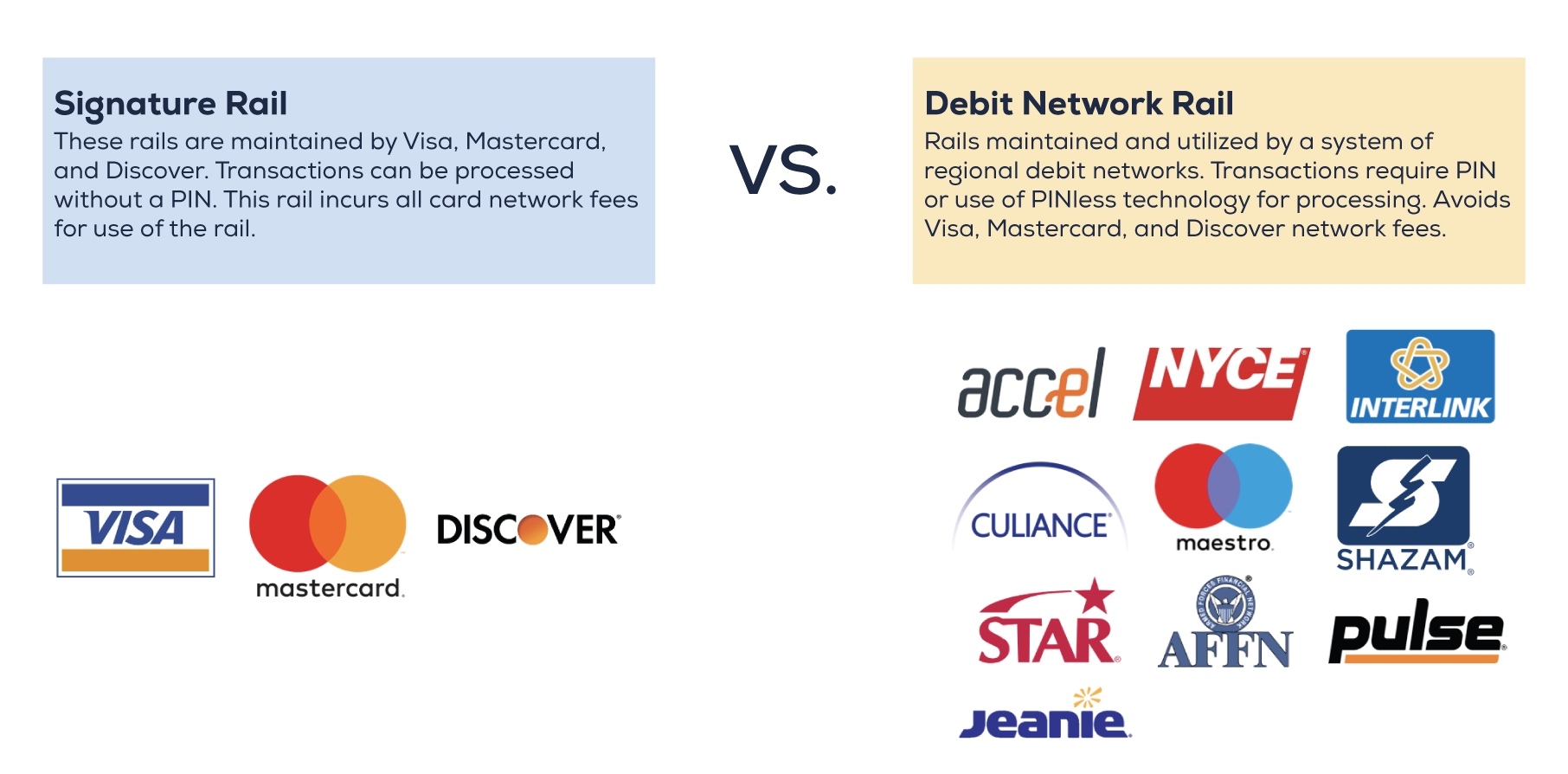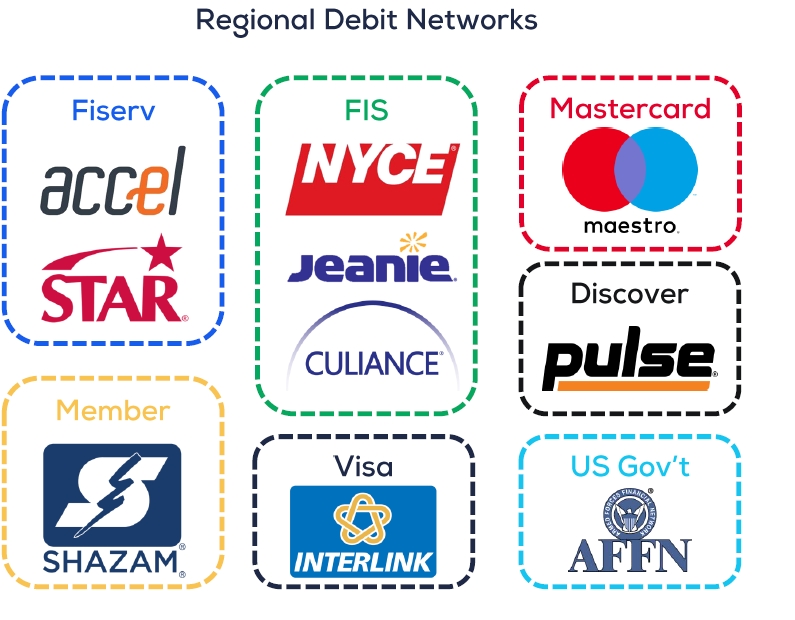The U.S. Department of Justice’s plan to probe Visa’s debit card routing practices and what it means for businesses
We talk a lot about PIN debit, PINless debit, and PIN debit routing here at Redbridge. The regional debit networks in the U.S. play a pivotal role in the payments ecosystem, providing reliable networks to conduct our debit transactions over. That being said, many consumers go about their day without even realizing that there is a war being waged over exactly how they use their debit cards.
It was not until Europay, Mastercard, and Visa (EMV) made one aspect of using a debit card abundantly clear, the choice between “Visa Debit” and “US Debit.” “Excuse me, what?”: A common reaction from consumers who for years either bypassed entering their PIN or simply completed the PIN prompt. This was truly the first time the consumer got a peek behind the curtain to see the battle being fought over routing choices between merchants, the networks, and issuers.
The Department of Justice’s probe into Visa’s practices around debit routing is incredibly fascinating. While it has yet to be determined whether the practices are truly anti-competitive, from a merchant advocacy perspective, they do wield a sizable influence and it does appear that steps have been taken to limit competition in an ever-growing competitive landscape.
Important considerations within this landscape are the players and their “rails.”
Signature debit vs. PIN debit rails
On one side we have the signature debit rails, often referred to as “processing as credit,” which are maintained by the major networks like Visa, Mastercard, and Discover. In the other corner is the true debit rail, which is maintained by regional debit networks like Interlink, Maestro, Accel, STAR, NYCE, Pulse, Jeanie, Culiance, Shazam, and AFFN.

It is important to note who owns these debit networks, as the exhibit below details.

Market share by regional debit network
According to data accumulated from our database, we wanted to provide some insights into market share. In the card present space, we see the following market shares in terms of dollar volume:
- 47% – Interlink
- 25% – STAR
- 13% – Maestro
- 12% – PIN Authorized Visa Debit
- 3% – All other networks
When we reviewed our data to perform the same exercise in the card not present space, we saw the following market share in terms of volume:
- 60% – STAR
- 20% – Pulse
- 15% – NYCE
- 5% – Accel
With the stage now set, the conversation can truly take shape on why this probe is likely to yield, at its minimum, very interesting information.
The Durbin Amendment explained
One piece of legislation that nearly all merchants are familiar with is the Durbin Amendment. This still stands as the only piece of major legislation that has any impact on regulating the fees a merchant pays for accepting card payments. While this is limited to debit card payments, both signature and PIN, having debit interchange regulated to just 0.05% plus $0.22 (in most cases) from cards issued by banks with greater than $10 billion in assets was a win for most — not all, but most. Beyond just this fee regulation, however, came other critical elements: the addition of requiring two unaffiliated debit card networks for least cost routing and the merchant’s ability to direct this routing.
Merchants do very much flex their routing muscles, using a series of consumer behavior shifting tactics as well as complex routing hierarchies. As discussed in our previous article regarding PIN debit, merchants can lower their acceptance costs through these strategies while still providing a high-quality consumer experience. This, on the surface, sounds great for merchants; however, even the PIN space is dominated by Visa and Mastercard’s combined 70% plus market share. This begs the question, how much choice and competition is there considering the market share and how did it get this way?
Network incentives create limitations for merchants using PINless debit routing
While Visa and other major networks often create incentive arrangements with individual merchants regarding preferred routing, these networks creating incentive arrangements with issuing banks, as alleged, becomes problematic. This is especially so under the lens of a card not present environment, such as mobile or e-commerce. We have talked about this before, where only a few regional debit networks can support PINless debit routing. Those networks are STAR, Accel, NYCE, and Pulse. If a merchant wanted to be in more control of their routing and utilize PINless as a strategy, they could only influence customers with cards issued with at least one of these networks.
Visa and Mastercard have no incentive to have Interlink and Maestro participate as PINless networks as this cannibalizes their signature debit rails. As this probe is seeking to address, they do have incentives to arrange deals with issuers to allegedly reduce competition by offering incentives to advance their PIN networks at the expense of others. Whether this is a fair market practice is clearly up for debate, and we are certain that more information will become available as to how the global brands flex their incentive dollars. That being said, we at Redbridge certainly do feel some type of way.
How merchants can level the playing field
There is a fundamental difference between a merchant taking control of their PIN debit routing and PIN debit optimization by seeking beneficial arrangements with their partners and a major network, such as Visa, allegedly reducing competition by going to the source — issuers. By market share alone, it is clear that these major networks can impose their influence over issuers. We certainly are not denying that in some cases it may be very valid, but utilizing incentive arrangements with issuers does not seem like a fair or competitive practice. As industry watchdogs and fierce merchant advocates, we will be watching this story closely.
Considering there is no definitive timeline as to the results of this probe or any actions and no finality to the prior anti-trust suit against Visa and Mastercard, we have proactively been working with our clients to level the playing field.
Redbridge offers a unique service called Payment Channel Optimization and Architecture that is designed to holistically address the inequalities within the system. We would be happy to discuss with you more about this service and what it could mean for your business.
